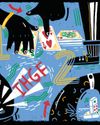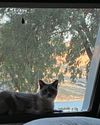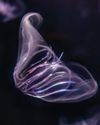
Help Wanted: Expedition seeks explorers brave enough to face bizarre, glow-in-the-dark creatures. Must be able to navigate safely past vents spewing liquid carbon dioxide, erupting mud volcanoes, and a treacherous lake of molten sulfur.
What strange corner of the universe is this expedition headed for? It's a cozy little planet known as Earth and a spot miles under the surface of the Pacific Ocean called the Mariana Trench.
A Hole in the Ocean Floor
In 1872, the HMS Challenger expedition set out to map the ocean floor. The explorers spent four years crisscrossing the globe, sailing 70,000 miles (112,654 kilometers)-one-third of the distance to the Moon. It was backbreaking, boring work. Sail about 200 miles (322 kilometers), drop a weighted rope into the water. Measure how much rope it took to hit bottom. Sail another 200 miles and do it again. And again. This expedition was a total snooze fest, until a day in 1875 about 200 miles (322 kilometers) off the coast of Guam. That morning, when the to pe was dropped, the ocean swallowed up five miles (eight kilometers) of it. The Challenger's crew had discovered a "hole" in the ocean floor.
Braving the Depths
It wasn't until the 1950s that we knew just how big Challenger's discovery was. Scientists turned to sonar, an instrument that sends out sound waves and measures how long it takes them to come back. They discovered that the hole is actually a trench. It is crescent-shaped and twice as long as the state of California and 43 miles (69 kilometers) wide. Parts of the trench are only five miles (eight kilometers) deep, but at its southern end, the trench drops to almost seven miles (11 kilometers). That means if you planted Mount Everest on the bottom and stacked three Empire State buildings on top, you still wouldn't reach the surface of the ocean.
Denne historien er fra July/August 2023-utgaven av Muse Science Magazine for Kids.
Start din 7-dagers gratis prøveperiode på Magzter GOLD for å få tilgang til tusenvis av utvalgte premiumhistorier og 9000+ magasiner og aviser.
Allerede abonnent ? Logg på
Denne historien er fra July/August 2023-utgaven av Muse Science Magazine for Kids.
Start din 7-dagers gratis prøveperiode på Magzter GOLD for å få tilgang til tusenvis av utvalgte premiumhistorier og 9000+ magasiner og aviser.
Allerede abonnent? Logg på

HOUSE OF CARDS
TRY THE PERFECT EXPERIMENT—AND THEN REFLECT ON HOW IT WENT.

ACCIDENTALLY Delicious
Have you ever been really hungry, but there wasn't much to eat in your kitchen? Did you throw together a bunch of stuff you had on hand and were pleasantly surprised when it tasted good?

IS YOUR SOCIAL MEDIA FEED TOO PERFECT?
EVERYONE'S LIFE CAN APPEAR PERFECT ON SOCIAL MEDIA. On YouTube, Instagram, Snapchat, and similar apps, people tend to share their happiest, most picturesque moments. They carefully compose any text to get the message just right. They use filters and enhancements to glam up images and videos. The app sorts the posts with the most likes and comments to the top. The end result? All you see of others' lives is the best of the best.

Art ALERT!
THE CASE OF THE MASTERPIECE THAT WASN'T

MARYAM ZARINGHALAM
SCIENCE POLICY FELLOW AND WRITER

Lost Cat Treks More Than 800 Miles to Get Home
Rayne Beau (pronounced RANE-BO, as in \"rainbow\") is a two-year-old Siamese cat.

EASY AS ABC
But in number theory, well, it's complicated.

That Wanaka Tree Gets a Companion
\"THAT WANAKA TREE,\" AS IT'S CALLED, IS A FAMOUS WILLOW TREE THAT GROWS OUT OF LAKE WANAKA ON THE SOUTH ISLAND OF NEW ZEALAND.

Two College Students Devise Smart Glasses That Can ID People
YOU'RE WAITING FOR THE SUBWAY WITH A COUPLE OF YOUR FRIENDS.

Two Comb Jellies Can Fuse Their Bodies Together to Become One
COMB JELLIES ARE GELATIN-LIKE AND MOSTLY SEETHROUGH INVERTEBRATES, OR ANIMALS WITHOUT A BACKBONE, THAT FLOAT IN THE OCEAN NEAR SHORE.
